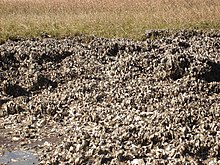Eastern oyster
| Eastern oyster | |
|---|---|
 |
|
| Oyster bed on Cockspur Island, Georgia, USA | |
| Scientific classification | |
| Kingdom: | Animalia |
| Phylum: | Mollusca |
| Class: | Bivalvia |
| Order: | Ostreoida |
| Family: | Ostreidae |
| Genus: | Crassostrea |
| Species: | C. virginica |
| Binomial name | |
|
Crassostrea virginica Gmelin, 1791 |
|
The eastern oyster (Crassostrea virginica)—also called Wellfleet oyster,Atlantic oyster, Virginia oyster, or American oyster—is a species of true oyster native to the eastern seaboard and Gulf of Mexico coast of North America. It is also farmed in Puget Sound, Washington, where it is known as the Totten Inlet Virginica. Eastern oysters are and have been very popular commercially. Today, less than 1% of the original 17th-century population (when the original colonists arrived) is thought to remain in the Chesapeake Bay and its tributaries, although population estimates from any era are uncertain. The eastern oyster is the state shellfish of Connecticut, its shell is the state shell of Virginia and Mississippi, and its shell in cabochon form is the state gem of Louisiana.
Like all oysters, Crassostrea virginica is a bivalve mollusk with a hard calcium-carbonaceous shell. Its shell provides protection from predation.
This particular type of oyster has an important environmental value. Like all oysters, C. virginica is a filter feeder. They suck in water and filter out the plankton and detritus to swallow, then spit the water back out, thus cleaning the water around them. One oyster can filter more than 50 gallons of water in 24 hours. Eastern oysters also provide a key structural element within their ecosystem, making them a foundation species in many environments, and they serve as ecosystem engineers in western Atlantic estuaries. Similar to coral reefs, oyster beds provide key habitat for a variety of different species by creating hard substrate for attachment and habitation. Oyster beds have an estimated 50 times the surface area of an equally sized flat bottom. The beds also attract a high concentration of larger predators looking for food.
...
Wikipedia
